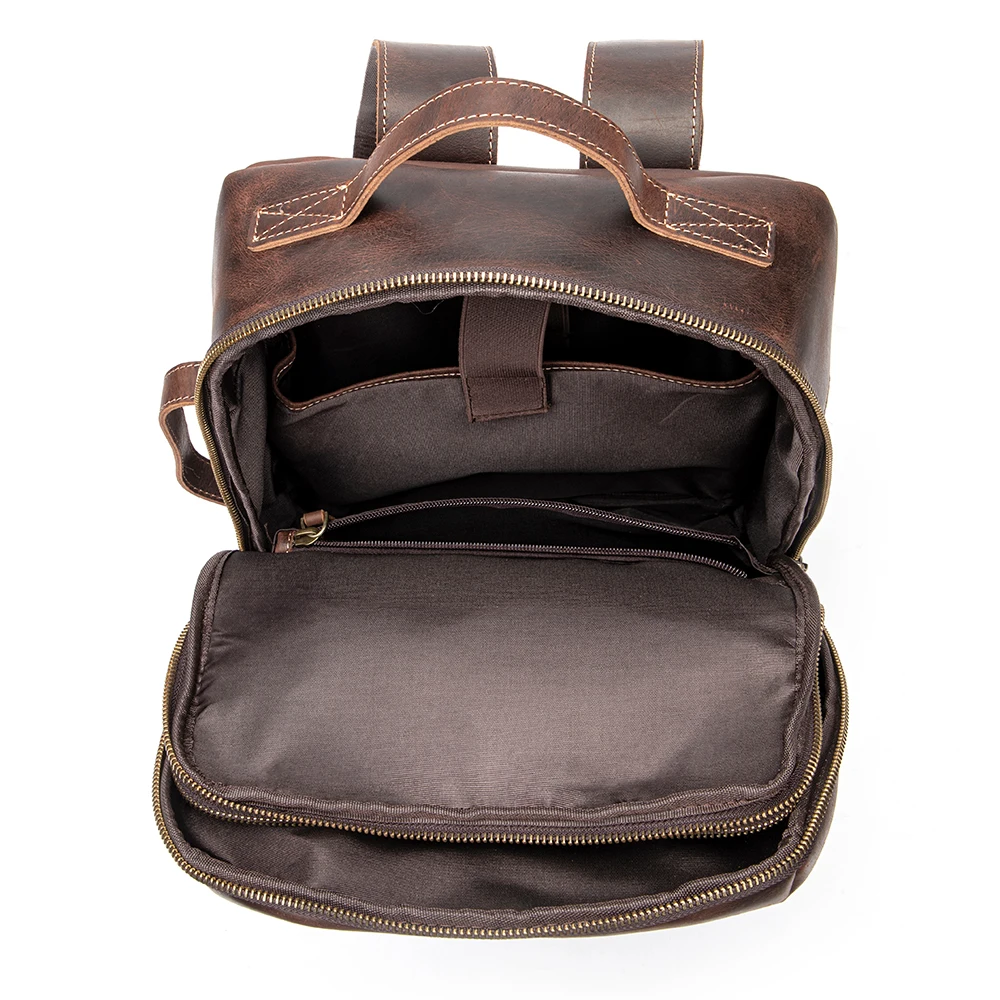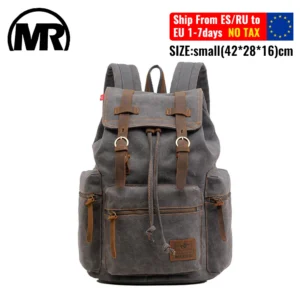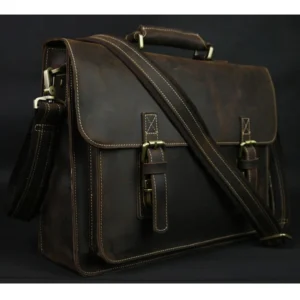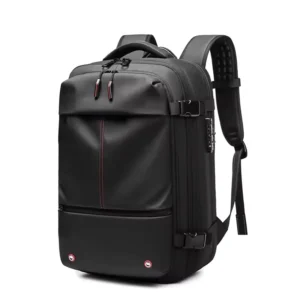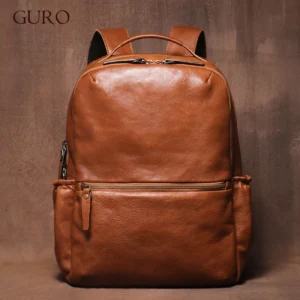Understanding Structured Leather Backpacks: Beyond the External Silhouette
When we talk about structured leather backpacks, we’re referring to bags designed with intentional shape and form that maintain their silhouette regardless of what’s inside. Unlike their unstructured counterparts that may collapse when empty, structured backpacks feature engineering elements that create and preserve their shape.
What makes a backpack “structured” typically includes:
- Rigid backing panels that maintain vertical alignment
- Reinforced bottom panels preventing sagging when fully loaded
- Strategic internal framework that preserves the bag’s intended shape
- Premium materials like full-grain leather that naturally provide more structure
The relationship between a backpack’s external structure and its internal organization is deeply intertwined. A well-structured backpack doesn’t just look better—it functions better by maintaining the integrity of compartments, protecting your belongings, and ensuring accessibility even when fully packed.
At Summit Carry, we’ve found that thoughtful internal organization requires a stable foundation. The use of premium full-grain leather combined with structured design elements creates backpacks that not only look sophisticated but also serve as reliable organizational tools for years to come. Regular leather conditioning and waterproofing helps preserve this structural integrity over time.
In this guide, we’ll explore the ingenious ways full-grain leather backpacks are organized internally to accommodate diverse needs, from business professionals to tech enthusiasts to minimalist everyday carriers.
How Structure Influences Interior Organization
The structured nature of premium leather backpacks directly impacts their interior functionality in ways that might not be immediately obvious. This relationship between external rigidity and internal organization creates a foundation for everything that makes a quality backpack work.
External structure benefits internal organization in several key ways:
- Prevents compartment collapse, keeping items accessible rather than bunched at the bottom
- Maintains separation between sections, preventing items from shifting or becoming jumbled
- Protects delicate contents through consistent padding and support
- Allows for precise placement of organizational features that stay where they’re meant to be
The construction elements that create this structure include PE (polyethylene) boards, semi-rigid foam panels, and strategic reinforcement at stress points. These components work harmoniously with full-grain leather’s natural structure, which offers inherent stability that synthetic materials often try to mimic but rarely achieve.
High-quality leather backpacks strike a delicate balance between rigidity and flexibility. Too rigid, and the backpack becomes uncomfortable and inflexible; too soft, and it loses organizational integrity. Properly conditioning your leather backpack helps maintain this perfect balance throughout its lifetime.
The best structured backpacks don’t announce their engineering—instead, they quietly maintain their shape while facilitating organized daily life, growing more supple without losing function over years of use.
Essential Components of Premium Internal Layouts
When examining the internal organization of quality structured leather backpacks, several core components emerge as standard across premium designs. These elements work together to create a cohesive system rather than just a collection of random pockets.
Main Compartment
- Primary storage area with sufficient depth and width
- Often features additional organizational elements inside
- May include drawstring closures or wide-opening designs
Device Protection
- Padded laptop sleeve positioned against back panel
- Often includes separate tablet pocket with softer lining
- Positioned to distribute weight properly against the back
Organizational Panels
- Dedicated sections with multiple small pockets
- Typically positioned for easy access, often in front compartments
- Includes various specialized holders for pens, cards, and small items
Secondary Compartments
- Additional separated spaces for category-specific storage
- May include side pockets, front pockets, or hidden compartments
- Provides isolation for items that need quick access
The mark of thoughtful internal design versus afterthought organization lies in the intentionality behind each component. In premium backpacks, you’ll notice organizational features that anticipate real-world needs rather than generic pockets added as an afterthought. The benefits of sturdy leather backpacks extend beyond durability to include this thoughtful organizational design.
What truly distinguishes quality internal layouts is how these components work together as an integrated system rather than competing for space.
The Main Compartment: Your Backpack’s Core Space
The main compartment forms the heart of any structured leather backpack, serving as the central storage area around which all other organizational features revolve. This primary space typically accounts for 50-70% of a backpack’s total volume and determines how efficiently you can pack larger items.
The design of this core space varies significantly across different backpacks:
- Top-loading designs: Provide security but may limit accessibility to items at the bottom
- Clamshell openings: Allow the bag to open like a suitcase for full visibility and access
- Drawstring with flap closures: Offer quick access with adjustable volume
The proportional balance of the main compartment relative to secondary compartments directly impacts how you’ll use the backpack. Business-oriented designs typically feature larger main compartments for documents and larger items, while tech-focused backpacks might dedicate more space to dedicated device compartments.
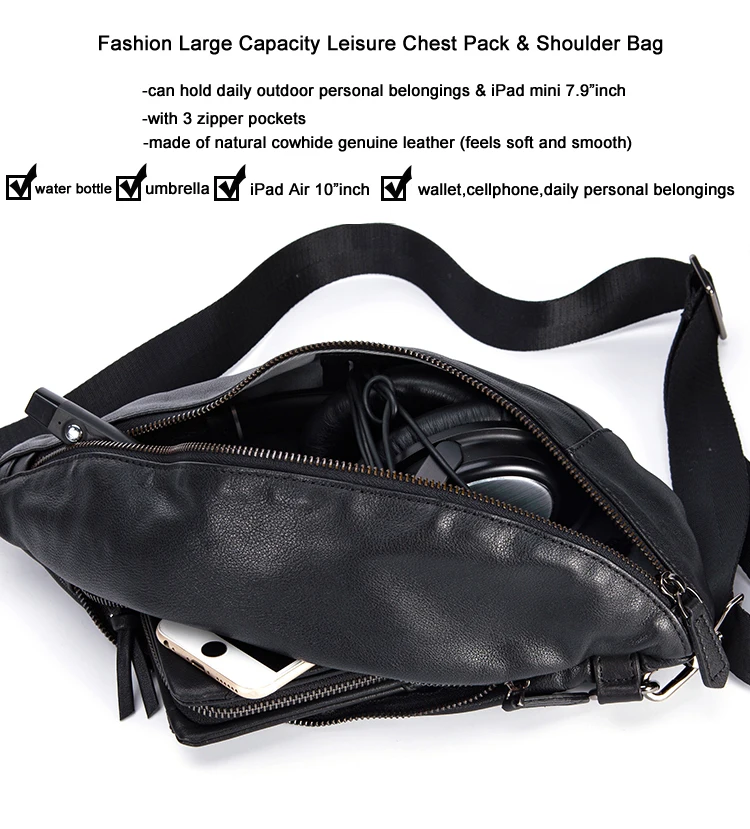
For context, large leather backpacks typically feature main compartments ranging from 16-20 inches (40-50 cm) in height, with depths ranging from 4-6 inches (10-15 cm). These dimensions allow for carrying laptops, books, clothing, and other daily essentials while maintaining the backpack’s structured form.
The integration of the main compartment with other sections is crucial for overall usability—well-designed backpacks ensure smooth transitions between spaces without awkward barriers or wasted areas.
Laptop and Tablet Protection Systems
Among the most critical components of modern structured leather backpacks are the dedicated protection systems for electronic devices. These features have evolved from simple sleeves to sophisticated protection systems that shield valuable technology while maintaining accessibility.
Common Laptop Protection Approaches
| Feature | Description | Benefit |
|---|---|---|
| Padded sleeve | Foam-lined compartment with soft interior | Protects against bumps and minor impacts |
| Suspended design | Sleeve that prevents laptop from touching bottom | Shields from drops and sets device above floor |
| Full compartment | Separate zippered section dedicated to laptop | Provides isolation and added security |
| Corner protection | Reinforced areas at vulnerable points | Guards against the most common damage points |
The positioning of laptop compartments significantly impacts both protection and comfort. Most premium designs place laptops directly against the back panel, which serves multiple purposes: it provides rigid protection, distributes weight evenly against your back, and prevents other items from pressing against the device.
Size compatibility is another crucial consideration. Leather laptop backpacks typically accommodate devices ranging from 13” to 17” displays, with the most versatile designs featuring sleeves that secure smaller laptops while still accommodating larger ones. Proper padding thickness (usually 0.25-0.5 inches or 0.6-1.3 cm) strikes the balance between protection and bulk.
Many modern designs now include separate tablet sleeves with softer, scratch-resistant lining materials like microfiber or soft felt. These are typically positioned for convenient access, often in front of the laptop sleeve or in a secondary compartment.
Specialized Organizational Features for Small Items
While large compartments handle your bulkier possessions, the true test of a premium leather backpack lies in how thoughtfully it manages your smaller daily essentials. These specialized organizational features prevent the frustration of digging through a bag to find keys, pens, or business cards.
Premium structured backpacks incorporate a variety of small-item organization strategies:
- Tiered pocket systems with visibility of all contents
- Elastic retention straps that adjust to different-sized items
- Color or material contrasts to easily identify different sections
- Strategic positioning based on access frequency and item importance
The materials used for these organizational elements often differ from the exterior leather, selected specifically for functionality. Common options include:
- Ripstop nylon for durability in high-wear areas
- Microfiber for scratch-sensitive items like glasses or screens
- Leather trim for frequently accessed areas that will develop a patina
- Water-resistant linings for items that might leak or spill
Balancing fixed organization with flexibility is crucial for long-term satisfaction with your backpack. The best designs include some dedicated purpose-built features alongside more versatile open pockets. Properly caring for your leather travel backpack helps ensure these specialized features maintain their functionality over time.
Securing Valuables: Internal Zippered Pockets
Internal zippered pockets provide essential security for your most valuable items within the controlled environment of your backpack. Unlike external pockets that might be accessible to others, these secure compartments offer peace of mind for items requiring extra protection.
Strategic placement of zippered security pockets varies based on intended use:
- Upper sections for frequently accessed valuables like phones
- Deep interior placements for rarely-needed but important items like passports
- Against the back panel for maximum theft prevention
- Within other compartments for layered security
Premium structured backpacks typically include 2-4 internal zippered pockets of varying sizes, from small coin/key pockets (approximately 3×4 inches or 7.5×10 cm) to larger document pockets (roughly 6×8 inches or 15×20 cm).
Enhanced security features found in quality designs might include:
- Water-resistant zippers that prevent moisture intrusion
- RFID blocking materials that protect electronic cards and passports
- Hidden zipper designs that aren’t visible from the outside
- Soft lining materials that prevent scratching of delicate items
These secure pockets are ideal for storing cash, identification, keys, and other small valuables that need to remain both secure and easily accessible throughout your day.
Quick-Access Features: Slip Pockets and Panels
Complementing secure zippered compartments, slip pockets and organizational panels provide immediate access to frequently-used items without the need to negotiate zippers or closures. These quick-access features save valuable time when retrieving items needed multiple times daily.
Well-designed slip pockets are strategically positioned for intuitive access:
- Upper portions of the main compartment for items like sunglasses or hand sanitizer
- Front compartments for transit cards or parking passes
- Side panels for water bottles or compact umbrellas
- Against divider panels for notebooks or thin folders
The materials used for slip pockets often provide gentle tension to hold items securely without fully restraining them. Elasticated openings are particularly useful for accommodating various item sizes while preventing accidental fallout when the bag is in motion.
Leather briefcase backpacks often feature the most sophisticated quick-access systems, combining professional organization with practical usability. These designs understand that efficiency is as important as protection for business environments.
The ideal balance in any structured leather backpack is a thoughtful combination of secure zippered pockets for valuables alongside convenient slip pockets for frequently-accessed items, creating an intuitive organizational system that adapts to your daily routine.
Specialized Holders: Pens, Cards, Keys and Tech
The finest structured leather backpacks include purpose-built holders for specific everyday items, eliminating the frustration of searching through larger pockets for small essentials. These specialized organizational elements reveal the thoughtfulness behind premium backpack design.
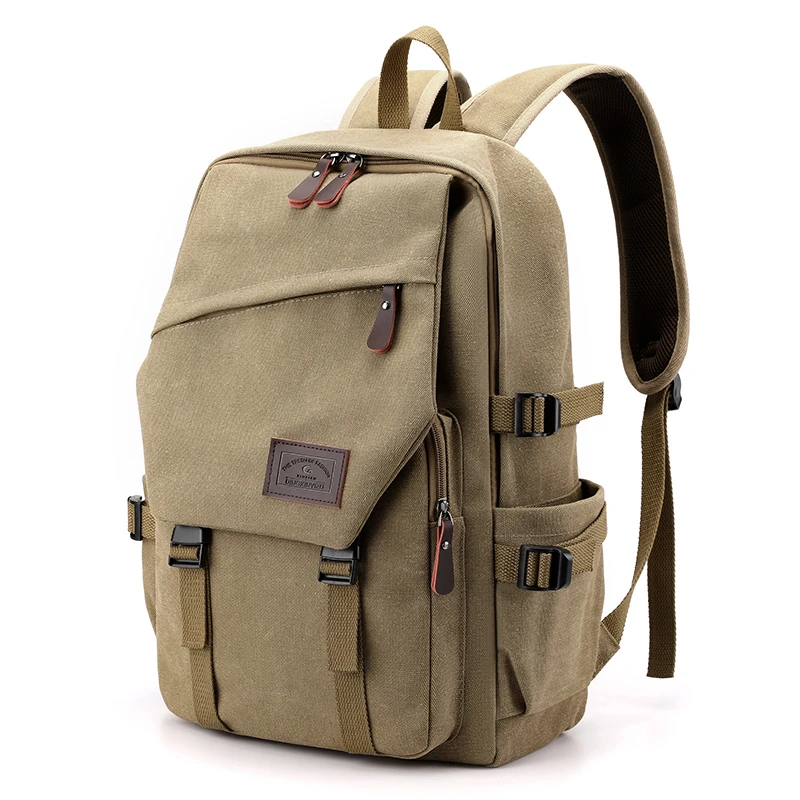
Common specialized holders include:
- Pen loops: Usually 0.5-0.75 inches (1.3-1.9 cm) in diameter, positioned vertically for quick access
- Card slots: Typically 2.25×3.5 inches (5.7×8.9 cm), often angled for visibility of contents
- Key leashes: Elastic or leather straps with clips allowing keys to be used while remaining attached
- Cable organizers: Elastic loops or dedicated pockets that prevent cord tangling
- Power bank pockets: Often positioned near cable pass-throughs for charging on-the-go
Material selection for these specialized holders is crucial for both function and longevity. Options range from elastic bands that accommodate various sizes to leather slots that develop character with use, and microfiber-lined pockets that protect delicate items like sunglasses or screens.
Innovation in this area continues to evolve, with features like magnetic pen holders, RFID-blocking card wallets, and integrated battery storage becoming more common in premium designs. The best backpacks anticipate not just what you carry today, but how your technology and everyday carry items might evolve over the bag’s lifetime.
Internal Dividers: Creating Customized Spaces
Internal dividers transform single large compartments into versatile, customized spaces, allowing for both separation and organization of your belongings. These structural elements prevent items from shifting during transport and create logical zones within your backpack.
Premium structured leather backpacks incorporate dividers in several distinct ways:
- Fixed full dividers: Complete panels separating main compartments from secondary spaces
- Partial height dividers: Panels that create separation while allowing larger items to span across
- Removable dividers: Adjustable panels (often attached with hook-and-loop fasteners) for customization
- Floating dividers: Panels connected only at sides or bottom, creating flexible division
Materials used for dividers must balance structure with flexibility and weight. Common options include:
- Padded panels with foam cores for protection between sections
- Rigid PE board dividers for maximum separation and structure
- Leather or textile dividers that fold when not needed
- Mesh or transparent dividers that maintain visibility between sections
The strategic placement of dividers dramatically affects a backpack’s versatility. Business-oriented designs might use dividers to create document sections separate from technology, while travel-focused backpacks might feature dividers that separate clean clothing from worn items or shoes.
When evaluating a structured leather backpack’s internal divider system, consider both your current organizational needs and how adaptable the system will be to changing requirements throughout the backpack’s lifetime.
Premium Materials in Internal Construction
While exterior leather quality often receives the most attention, the materials used inside a structured leather backpack significantly impact both functionality and longevity. These interior materials must withstand daily friction, resist staining, and maintain their appearance despite limited visibility.
Premium internal construction materials commonly include:
- Lining fabrics: Cotton twill, nylon, polyester, or occasionally leather
- Hardware: YKK zippers, metal D-rings, and reinforced stitching points
- Structural elements: PE boards, foam panels, and reinforcement at stress points
- Specialty materials: Microfiber for electronics, waterproof linings for certain compartments
The quality of these materials creates noticeable differences in daily use. Higher-grade linings resist pilling and maintain their appearance even after years of reaching in and out. Quality zippers operate smoothly even around corners, while premium hardware withstands the stress of heavy items without bending or breaking.
Color and material choices inside the backpack serve both aesthetic and functional purposes. Lighter-colored linings improve visibility of contents, while contrasting materials help distinguish different compartments at a glance. Waterproofing treatments for leather bags must work harmoniously with these internal materials to provide comprehensive protection.
The intersection of premium external leather with thoughtfully selected internal materials creates backpacks that not only look luxurious but function flawlessly throughout their extended lifespan—often improving with age as the leather develops character while internal components maintain their integrity.
Four Essential Internal Layout Archetypes
After examining individual organizational components, it’s helpful to understand how these elements combine into cohesive internal layout styles that serve different user needs. Most structured leather backpacks fall primarily into one of four fundamental organization archetypes, each optimized for specific use cases.
- Business Professional Layout: Prioritizes document organization, professional appearance, and meeting essentials
- Tech-Centric Organization: Focuses on multiple device protection, cable management, and digital accessories
- Minimalist Everyday Carry: Emphasizes simplicity, versatility, and clean aesthetic with strategic organization
- Travel-Optimized Layout: Balances security features with accessibility for on-the-go essentials
Each archetype represents a different approach to solving organizational challenges, with distinct priorities and compromises. While many backpacks incorporate elements from multiple categories, understanding these foundational approaches helps identify which design will best serve your specific needs.
The following sections explore each archetype in detail, highlighting key characteristics and ideal use cases for each internal layout style.
Business Professional Layout: Organization Meets Elegance
The business professional internal layout prioritizes efficient organization of documents, professional tools, and presentation essentials while maintaining a sophisticated aesthetic. This arrangement supports seamless transitions between office, meetings, and business travel.
Key features of business-oriented internal layouts include:
- Document sleeves sized for standard letter/A4 papers without folding
- Business card holders and dedicated pen slots positioned for quick access
- Padded laptop compartment typically supporting 14-16 inch devices
- Strategically positioned quick-access pockets for phones and small electronics
- Interior water bottle pocket that maintains professional exterior appearance
These men’s leather work backpacks typically organize space vertically rather than horizontally, with clear separation between zones for technology, documents, and personal items. Interior materials tend toward professional neutrals with minimal contrast, creating a cohesive and sophisticated appearance when opened in professional settings.
The business professional layout excels at balancing formal presentation with practical functionality, allowing quick access to essentials during meetings while keeping personal items discreetly organized and separated from work materials. These designs particularly benefit professionals who regularly transition between office settings, client meetings, and commuting.
Tech-Centric Organization: Protecting and Managing Devices
For those carrying multiple devices and their associated accessories, tech-centric internal layouts provide specialized protection and organization systems focused on electronic equipment management. These designs prioritize device security while facilitating power management and connectivity.
Distinguished features of tech-focused internal layouts include:
- Multiple padded device compartments with size-specific protection
- Cable management systems including elastic loops and dedicated pockets
- Power bank storage with cable pass-throughs for on-the-go charging
- Protective materials that resist static and shield from electromagnetic interference
- Quick-access external pockets for frequently used tech accessories
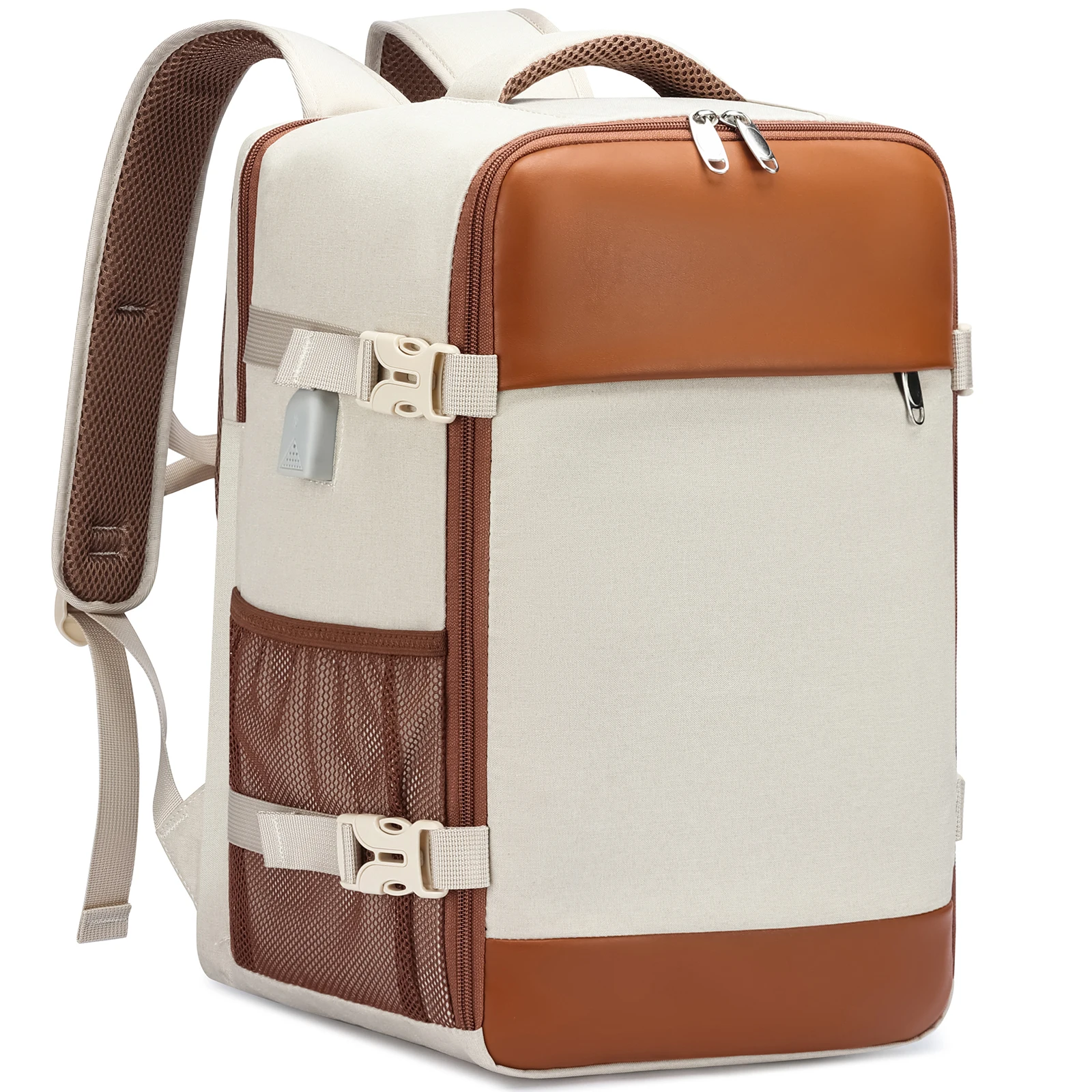
Tech-centric layouts typically organize space by device size and access frequency, with the largest devices against the back panel and progressively smaller accessories in forward compartments. These designs often incorporate more modern materials alongside leather, with microfiber linings, ripstop nylon dividers, and water-resistant pockets protecting sensitive electronics.
This organizational approach particularly benefits creative professionals, tech workers, and digital nomads who rely on multiple devices throughout their day and need to keep everything charged, protected, and readily available. The best tech-centric designs anticipate evolving technology needs while maintaining the timeless appeal of structured leather.
Minimalist Everyday Carry: Streamlined Organization
The minimalist internal layout embraces intentional simplicity, focusing on versatility and clean design rather than specialized compartments. This approach prioritizes adaptable space and intuitive organization over dedicated features, creating a backpack that evolves with changing daily needs.
Characteristic elements of minimalist internal organization include:
- Larger, more versatile main compartments with fewer fixed dividers
- Selective, purposeful organizational features rather than numerous small pockets
- Strategic use of space with nothing superfluous or redundant
- Emphasis on accessibility and flow rather than rigid categorization
- Clean visual aesthetic with harmonious materials and minimal contrast
Minimalist designs typically organize space through thoughtful placement of a few essential dividers rather than numerous small compartments. This creates a backpack that adapts to different contents rather than forcing items into predetermined spaces. Travel-ready leather backpacks often incorporate minimalist principles for maximum adaptability during journeys.
This organizational philosophy benefits those who carry different items on different days, prefer to use their own organizational pouches, or simply appreciate a cleaner aesthetic with less visual complexity. Minimalist designs tend to age particularly well, as fewer organizational components mean fewer potential failure points over years of use.
14 Inch Leather Laptop Backpack, Brown Leather Backpack, Men's Leather Backpack, Vintage Leather Backpack
Price range: $177.28 through $199.12 Select options This product has multiple variants. The options may be chosen on the product pageDesigner Men's Backpack, Men's Leather Laptop Backpack, Men's Leather Work Backpack
Price range: $158.04 through $160.04 Select options This product has multiple variants. The options may be chosen on the product page15 Inch Leather Laptop Backpack, Leather Briefcase Backpack
$332.96 Select options This product has multiple variants. The options may be chosen on the product page17 Inch Leather Laptop Backpack, Men's Leather Travel Backpack, Men's Leather Work Backpack
Price range: $106.28 through $143.88 Select options This product has multiple variants. The options may be chosen on the product pageFull Grain Leather Backpack, Men's Leather Laptop Backpack, Men's Leather Work Backpack
$353.46 Select options This product has multiple variants. The options may be chosen on the product page15 Inch Leather Laptop Backpack, Carry On Leather Backpack
Price range: $136.84 through $139.88 Select options This product has multiple variants. The options may be chosen on the product page
Travel-Optimized Layout: Security Meets Accessibility
Travel-focused internal layouts balance security features with convenient access to essentials while in transit. These designs accommodate the unique organizational challenges of travel, from document management to adapting to different environments throughout your journey.
Essential features of travel-optimized internal organization include:
- Secure document section for passport, boarding passes, and travel papers
- Hidden security pockets positioned against the back panel
- Compression straps or systems to secure contents during movement
- Quick-access pockets positioned for retrieval while wearing the backpack
- Strategic pocket placement that works while the bag is upright or horizontal
Travel-optimized layouts typically create distinct zones for different travel needs—secure storage for valuables, quick access for transit essentials, and adaptable space for items needed at the destination. These designs often incorporate more security features than other layouts, including RFID blocking materials, hidden zippers, and lockable compartments.
This organizational approach especially benefits frequent travelers who need to maintain organization through security checkpoints, during transit, and at their destination. The best travel-optimized backpacks adapt to different journey types while maintaining the sophisticated appearance of structured leather.
Matching Your Needs to the Ideal Internal Layout
Finding your perfect backpack organization system requires honest assessment of your daily carry needs and typical usage patterns. By evaluating what you carry, how you access it, and when you need it, you can identify which internal layout will best serve your lifestyle.
Consider these questions when determining your organizational needs:
- What are the three largest items you carry daily? These will dictate main compartment needs.
- How many electronic devices do you regularly transport? More devices suggest a tech-centric layout.
- Do you need quick access to specific items throughout the day? This determines pocket placement priorities.
- How frequently does what you carry change day-to-day? Variable needs might favor minimalist designs.
- Do you regularly transition between different environments? Consider layouts supporting multiple contexts.
For business professionals carrying laptops, documents, and meeting essentials, business-oriented layouts with document organization and professional presentation make sense. Digital creatives with multiple devices, cables, and accessories will benefit from tech-centric designs with device protection and cable management.
Those with simpler everyday carry needs or who prefer using their own organizational pouches might favor minimalist layouts that adapt to changing contents. Frequent travelers should prioritize security features alongside convenient access to travel documents and in-transit essentials.
The ideal internal layout aligns with not just what you carry, but how you interact with your belongings throughout your day.
Maximizing Your Backpack’s Internal Organization
Even with the perfect internal layout, how you use your backpack significantly impacts its organizational effectiveness. These practical strategies help maximize any structured leather backpack’s organizational potential:
- Assign dedicated locations for frequently-used items and consistently return them to those spots
- Use the bag’s natural structure by placing heavier items lower and closer to your back
- Add complementary pouches for small items that might otherwise get lost in larger compartments
- Regularly clean out accumulated items that add unnecessary weight and clutter
- Arrange items by access frequency, with most-used items in quick-reach locations
For optimal weight distribution and comfort, position the heaviest items (typically laptops or books) in the compartment closest to your back. Medium-weight items should occupy the middle space, with lighter items in front compartments or side pockets.
Consider supplementing your backpack’s organization with complementary accessories like slim cable organizers, compact card wallets, or small pouches for specific categories of items. These additions work with your backpack’s existing structure to create customized organization.
Remember that premium leather backpacks typically become more accommodating over time as the leather softens. What might feel slightly tight when new will likely develop into a perfectly fitted space as the bag breaks in through regular use.
Hidden Features That Enhance Organization
Beyond obvious pockets and compartments, premium structured leather backpacks often incorporate subtle organizational features that reveal themselves through use. These thoughtful design elements enhance functionality without compromising the clean aesthetic that makes leather backpacks so appealing.
Look for these hidden organizational enhancements in quality designs:
- Magnetic closure pockets that provide quick access while maintaining security
- Expandable gussets that allow compartments to accommodate varying contents
- Key clips positioned in unexpected locations for secure but accessible key storage
- Secret document pockets integrated into back panels or dividers
- Multipurpose features like straps that work for both compression and attachment
Innovative organizational solutions continue to evolve in modern backpack design, with features like integrated luggage pass-throughs, convertible straps that allow alternative carry methods, and modular internal components appearing in premium offerings.
Future trends in internal backpack organization point toward increased personalization, with some manufacturers exploring removable organizational panels, magnetic attachment systems for accessories, and even integrated technology like battery systems with wireless charging capabilities.
The best structured leather backpacks balance innovation with timeless design, incorporating useful organizational features without surrendering to trends that might quickly become obsolete.
Can Leather Backpacks Offer Better Organization Than Synthetic Options?
When comparing leather backpacks to synthetic alternatives specifically for organizational capability, both material approaches offer distinct advantages. The choice ultimately depends on your specific priorities and how you value different organizational attributes.
Leather backpacks typically excel in several organizational aspects:
- Structural integrity: Premium leather maintains its shape better over time, preserving organizational systems
- Aging characteristics: Full-grain leather adapts to contents, creating personalized fit for regularly carried items
- Durability of organizational features: Leather-reinforced pockets and dividers typically outlast synthetic alternatives
- Tactile functionality: Leather provides natural friction that prevents small items from sliding around
Synthetic backpacks may offer advantages in:
– Weight efficiency (lighter materials allow more organization without adding weight)
– Weather resistance (though properly treated leather performs admirably)
– Color options for visual organization (interior contrast for visibility)
What truly distinguishes premium leather backpacks is their ability to combine sophisticated organization with materials that improve with age. While synthetic backpacks often show wear at stress points and organizational features, quality leather backpacks develop character while maintaining functional integrity.
The organizational systems in premium leather backpacks typically represent a more substantial investment in design and materials, resulting in more thoughtful, durable solutions that continue functioning effectively throughout the backpack’s extended lifetime.
How Do Internal Layouts Evolve Over the Backpack’s Lifetime?
Unlike disposable synthetic bags, premium structured leather backpacks evolve meaningfully throughout their lifespan, with both the leather exterior and internal organizational systems adapting to your specific use patterns over time.
During the initial breaking-in period (typically the first 2-4 weeks of regular use):
– Leather components soften slightly while maintaining structure
– Zippers and hardware become smoother in operation
– Initial stiffness in organizational panels relaxes to accommodate contents
Through regular use over the first year:
– Interior pockets develop slight stretching to accommodate frequently stored items
– Dividers and panels conform to your typical load
– Access patterns become more intuitive as the bag adapts to your habits
With proper care over many years:
– Leather components develop a personalized patina reflecting your use
– Organizational features mold to your specific items
– The backpack becomes increasingly personalized to your carrying style
Maintenance plays a crucial role in how organizational systems age. Regular cleaning of interior spaces prevents dust and debris accumulation that can interfere with zippers or hook-and-loop fasteners. Occasional repositioning of dividers prevents permanent creasing that might limit future adaptability.
The finest structured leather backpacks are designed with this evolution in mind—constructed to not only withstand years of use but to improve through that use, becoming increasingly personalized organizational tools that reflect your specific needs and habits.

